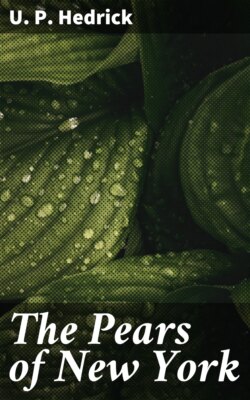Читать книгу The Pears of New York - U. P. Hedrick - Страница 6
На сайте Литреса книга снята с продажи.
WILD PEARS
ОглавлениеTable of Contents
Botanists number from twenty to twenty-five species of pears, all of which are found in the northern hemisphere of the Old World, there being no true pear native to the southern hemisphere or to the New World. Some ten or twelve wild pears are found in China, several of which overrun the limits of China; three or four are natives of Japan; at least one has its habitat in Korea; another is to be found in the western Himalayas; while the remainder, some eight or ten species, are found westward from Turkestan, through Persia and Asia Minor into southern and western Europe and northern Africa. From these statements as to habitats it is seen that pears grow wild over a very extended area and under quite varied conditions; therefore, it would be expected that the several species are quite distinct, differing chiefly, however, from a horticultural point of view, in the fruits.
But three of these wild species are now under common cultivation, though it is possible that through hybridization the blood of one or two more are to be found in cultivated varieties. Several others have horticultural possibilities either for their fruit, as means through which new characters may be introduced into cultivated pears, or as stocks upon which to grow orchard varieties. The three species of chief horticultural importance are Pyrus communis Linn., P. nivalis Jacq., and P. serotina Rehd.
The pear of common cultivation in ancient and modern orchards is Pyrus communis, native of southern Europe and Asia as far east as Kashmir. The species is now to be found naturalized in forests and byways of northern Europe, as it is in parts of America, so that it is impossible to tell precisely what its ancient habitat was. While most often to be found in mountainous regions in the great area which it inhabits, wild pears are common enough in the forests of Europe and western Asia so that it is probable that most of the early inhabitants of this part of the Old World enlivened their fare, obtained with the spear or the bow, with ready-made food from the pear. The species runs into at least three botanical forms, a dozen or more horticultural divisions and between two and three thousand orchard varieties.
Pyrus nivalis, the Snow pear, is a small tree native of southern Europe, more particularly of Austria and northern Italy, from which region it has spread in modern times as an escape from cultivation into neighboring countries. It is called Snow pear because the fruits are not fit to eat until after snow falls. The French call it the “Sage-leaved pear” (Poirier sauger), from the fact that the under side of the leaves is covered with down so that the leaf resembles that of garden sage. The Snow pear is cultivated in southern Europe, particularly in France, for the making of perry for which purpose several varieties are grown. Probably the Greeks and Romans used fruit of this species for perry so that it may be said to have had attention from man, if not care under cultivation, from the earliest times. It is doubtful if it has been hybridized with P. communis, parent of nearly all cultivated pears. The Snow pear is not cultivated in America but is to be found in botanical collections.
From Pyrus serotina came the Japanese, Chinese, or Sand pears of pomologists. The species is a native of central and eastern China and is found wild in Japan, but whether as a native or as an escape from cultivation it is impossible to say. There are three botanical forms of the species and possibly a score of horticultural varieties cultivated for their fruits and as ornamentals. Of all the species of Pyrus found in western Asia, this, in the light of present knowledge, is most closely related to the common pear, with which it hybridizes freely.
We have now discovered in what countries the progenitors of cultivated pears grow spontaneously, and are therefore ready to search for the first landmarks in the domestication of the three cultivated species. What has ancient literature to say on the subject? We turn first to the Bible and find that the pear is not mentioned in sacred literature, and that, according to commentators on the Sanscrit and Hebrew languages, there is no name in the tongues of Biblical lands for the pear. Nor should we expect ancient notices of the pear in north-west India or Persia, for the pear does not flourish in hot countries. The survey next turns to ancient Greece where landmarks are at once sighted which must be put down as the earliest records of the pear, and as such deserve full consideration.
